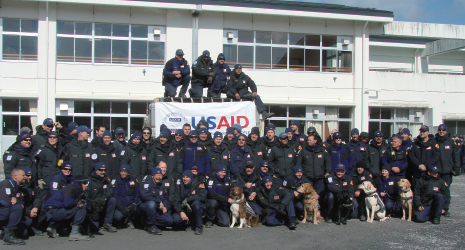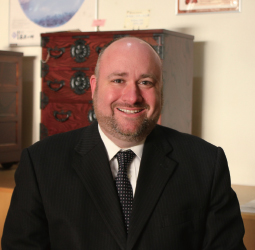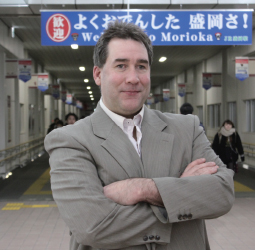Home > Highlighting JAPAN >Highlighting Japan March 2016>Five Years Down the Road to Reconstruction
Highlighting JAPAN


Dedicated Assistance
Like many foreign residents in Japan, two former JET Programme participants have been working hard to help Tohoku recover from the devastation of the 2011 catastrophe, volunteering in various roles in their respective communities in Iwate Prefecture.
Originally from Toronto, Canada, Mark Mino-Thompson got his start in Iwate Prefecture in 1999 as an English-language instructor with the JET Programme, the Ministry of Education, Culture, Sports, Science and Technology’s long-running initiative on grassroots education and internationalization.
Mino-Thompson returned briefly to Canada and came back to work for his original employer, the town office of Sumita, which is where he found himself when disaster struck on the afternoon of Friday, March 11, 2011. As public employees, Mino-Thompson and his coworkers quickly set up a tent stocked with emergency supplies for the community and began surveying the damage around Sumita’s municipal buildings.
“Since the earthquake and tsunami largely spared Sumita, it became the rallying point for relief efforts,” Mino-Thompson says. When foreign search and rescue workers arrived—including 150 from the U.S. and 70 from the UK—Mino-Thompson became a liaison between them, staff from the Ministry of Foreign Affairs and Sumita town hall, translating and interpreting as needed.
Mino-Thompson’s relief efforts took on a more personal aspect when he discovered an old kerosene heater he’d received from a friend. Unlike more modern models, this standalone unit did not require an electric outlet, so he had a source of heat to endure nights when temperatures dropped to near freezing. Mino-Thompson and his family became informal hosts, sharing their house with a small band of neighbors and friends.
Dean Ruetzler, a friend of Mino-Thompson’s and a fellow JET Programme teacher, came from the U.S. to Iwate a year earlier in 1998 to teach English for three years to special education students.
After his JET Programme stint, Ruetzler returned to the U.S. to handle Japanese inquiries for a mail-order company in New Hampshire, but later returned to Iwate as an English-language instructor. He was in the office at the high school in Morioka where he works when the earthquake hit.
“I’ve been in stronger quakes, so the scary thing about this one was not its strength but that it went on for over two minutes,” Ruetzler recalls.
Ruetzler says he was fortunate that the quake did not significantly affect his home. The next day—a Saturday—he drove over to AIINA, the Iwate Prefecture Citizen’s Cultural Exchange Center in Morioka that, according to Ruetzler, became a de facto emergency shelter. “I just showed up and asked, ‘What can I do to help?’ ” he says. Ruetzler spent most of the day interpreting for foreigners that came in, as well as translating information from Japanese into English so that center staff could post it on bulletin boards.
Ruetzler’s school canceled classes in the following weeks, so he partnered with other expatriates living in Morioka to gather and distribute supplies to people living in the stricken areas. During Japan’s Golden Week holiday period, which starts from the end of April, Ruetzler and others also volunteered to clean out mud from roadside gutters to facilitate transportation.
Five years on, Mino-Thompson and Ruetzler are looking ahead to Tohoku’s revival. The recovery is happening, Mino-Thompson observes, but at a gradual pace. “We need something that will bring in people and jobs,” he notes.
Both men see enormous potential in the project to build the International Linear Collider, a high-tech experimental facility for elementary particles in Iwate’s Oshu City. Looking to create something meaningful from Tohoku’s rejuvenation, Mino-Thompson and Ruetzler now devote time as volunteers to help bring the project to fruition, hoping the energy they expend will enable the Tohoku region to not merely recover but become even stronger than it was before March 11, 2011.
© 2009 Cabinet Office, Government of Japan








